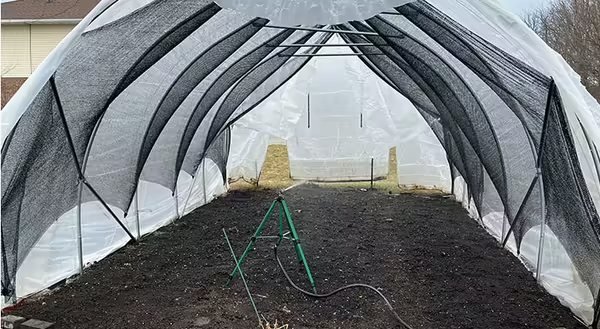
The high tunnel at the Unity Community Center was very lightly surface tilled in early January and a cover crop of oats, forage pea and hairy vetch was planted throughout, and top-dressed with compost, all in preparation for another year of ginger cultivation. We ordered 30lbs (!) of ginger seed and 5lbs of turmeric seed for what is shaping up to be an expanded version of a cross-Illinois fresh ginger rhizome project, involving several Extension personnel and 4-5 farmers. We will be testing best practices of fresh “baby” ginger rhizome production, from seed size, to spacing, planting furrow amendments, irrigation setup, fertility management, shade application vs. plastic application on tunnels, and other factors.
Last year, the left half of Unity Community Center’s Food Production Garden was no-till cover-cropped for the summer with sorghum-Sudangrass, pearl millet and cowpea. The Dean of Extension and his crew were very impressed with the nodulation on the cowpea roots as well as the biomass generation of the warm season grasses. We got that mowed down enough to no-till in some oats, field pea, and tillage radish in early September. Thanks to a warm fall, the warm season grasses regrew, but not before the fall cover crop got a nice start to it. We probably have about 2 solid inches of dead, decomposing biomass on top of that ground that we will make spade cuts into this year when we plant tomato, pepper, eggplant, tomatillo, and other plants. We are excited to see how those plants do with nitrogen fixation and biomass breakdown from the past year.
It has been a couple months since the last Central IL report so my weather observations will start in December. This has been one of the most pleasant winters I can remember – which is troubling. December’s daily average temperatures were mostly in the 40s, with a couple days in the 50s and even 60s. We had about 5 days in December when it got below freezing. Not normal. 4 days of the month, we got precipitation – 1-2” of rain, 1-2” of snow. Also not normal. Same goes for January. Drier than average, and warmer than average. We had a hard cold snap from about January 12th to January 24th. February has been off to a warm start as well – on the 9th, we got as warm as 63F.
Although it is snowing today on February 16th, all the warm winter weather is waking up the fruit trees at the Refuge Food Forest and the Unity Community Center in Normal, IL. Trees look to be about 2 weeks ahead of schedule. Some of the apples and some of the pears are in silver-tip stage! That should not be happening yet. I have instructed growers to get their pruning done by the first of March, instead of the 15th – my usual suggested cut-off date. It has been very humid, with days-long spells of fog and mist at the beginning of the month, and now snow and a little rain. Next nice stretch of weather is major pruning time at the Refuge Food Forest.
I’ll be having two in-person pruning workshops, covering 101 level knowledge of fruit tree pruning of apple and pear, though with some applicability to sour cherry, plum, and others. Dates of programs are March 6th and 14th at the Refuge Food Forest – 701 E Lincoln St., Normal, IL 61761. Registration is requested but not required at go.illinois.edu/lmw/events – I’m taking up to 20 people per session. I have tools for those who come wanting to learn but don’t have any – but those that have pruning tools are encouraged to bring them, including hand-pruners (sharpened), loppers, folding hand saws, and pole saws. Note: always bring and use isopropyl alcohol after cutting each tree before moving on to another, to prevent the spread of disease.